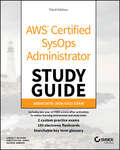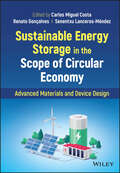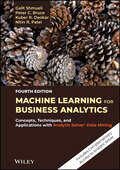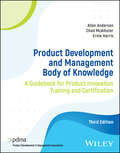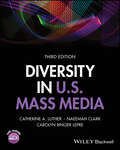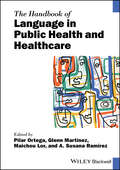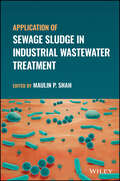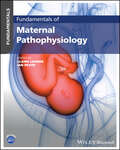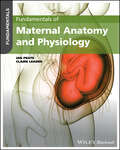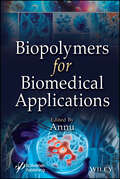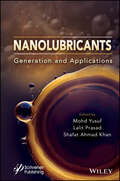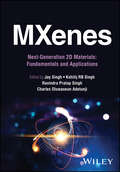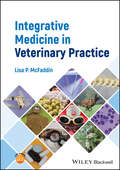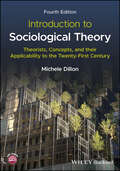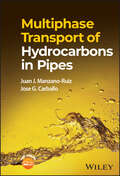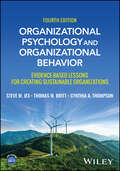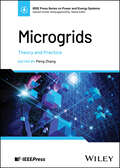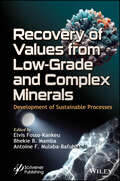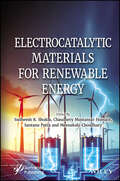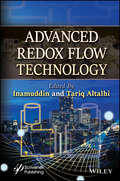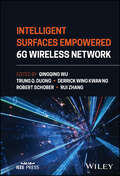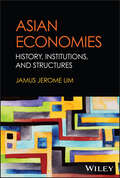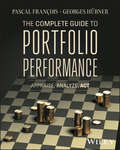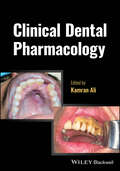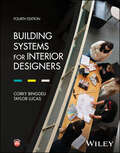- Table View
- List View
AWS Certified SysOps Administrator Study Guide: Associate SOA-C02 Exam (Sybex Study Guide)
by Jorge T. Negron Christoffer Jones George SawyerPrepare for success on the AWS SysOps exam, your next job interview, and in the field with this handy and practical guide The newly updated Third Edition of AWS Certified SysOps Administrator Study Guide: Associate (SOA-C02) Exam prepares you for the Amazon Web Services SysOps Administrator certification and a career in the deployment, management, and operation of an AWS environment. Whether you’re preparing for your first attempt at the challenging SOA-C02 Exam, or you want to upgrade your AWS SysOps skills, this practical Study Guide delivers the hands-on skills and best practices instruction you need to succeed on the test and in the field. You’ll get: Coverage of all of the SOA-C02 exam’s domains, including monitoring, logging, remediation, reliability, business continuity, and more Instruction that’s tailor-made to achieve success on the certification exam, in an AWS SysOps job interview, and in your next role as a SysOps administrator Access to the Sybex online study tools, with chapter review questions, full-length practice exams, hundreds of electronic flashcards, and a glossary of key terms The AWS Certified SysOps Administrator Study Guide: Associate (SOA-C02) Exam includes all the digital and offline tools you need to supercharge your career as an AWS Certified SysOps Administrator.
Sustainable Energy Storage in the Scope of Circular Economy: Advanced Materials and Device Design
by Carlos Miguel Costa Renato Gonçalves Senentxu Lanceros-MéndezSustainable Energy Storage in the Scope of Circular Economy Comprehensive resource reviewing recent developments in the design and application of energy storage devices Sustainable Energy Storage in the Scope of Circular Economy reviews the recent developments in energy storage devices based on sustainable materials within the framework of the circular economy, addressing the sustainable design and application of energy storage devices with consideration of the key advantages and remaining challenges in this rapidly evolving research field. Topics covered include: Sustainable materials for batteries and fuel cell devices Multifunctional sustainable materials for energy storage Energy storage devices in the scope of the Internet of Things Sustainable energy storage devices and device design for sensors and actuators Waste prevention for energy storage devices based on second life and recycling procedures With detailed information on today’s most effective energy storage devices, Sustainable Energy Storage in the Scope of Circular Economy is a key resource for academic researchers, industrial scientists and engineers, and students in related programs of study who wish to understand the state of the art in this field.
Machine Learning for Business Analytics: Concepts, Techniques, and Applications with Analytic Solver Data Mining
by Galit Shmueli Peter C. Bruce Kuber R. Deokar Nitin R. PatelMACHINE LEARNING FOR BUSINESS ANALYTICS Machine learning—also known as data mining or predictive analytics—is a fundamental part of data science. It is used by organizations in a wide variety of arenas to turn raw data into actionable information. Machine Learning for Business Analytics: Concepts, Techniques, and Applications with Analytic Solver® Data Mining provides a comprehensive introduction and an overview of this methodology. The fourth edition of this best-selling textbook covers both statistical and machine learning algorithms for prediction, classification, visualization, dimension reduction, rule mining, recommendations, clustering, text mining, experimentation, time series forecasting and network analytics. Along with hands-on exercises and real-life case studies, it also discusses managerial and ethical issues for responsible use of machine learning techniques. This fourth edition of Machine Learning for Business Analytics also includes: An expanded chapter on deep learning A new chapter on experimental feedback techniques, including A/B testing, uplift modeling, and reinforcement learning A new chapter on responsible data science Updates and new material based on feedback from instructors teaching MBA, Masters in Business Analytics and related programs, undergraduate, diploma and executive courses, and from their students A full chapter devoted to relevant case studies with more than a dozen cases demonstrating applications for the machine learning techniques End-of-chapter exercises that help readers gauge and expand their comprehension and competency of the material presented A companion website with more than two dozen data sets, and instructor materials including exercise solutions, slides, and case solutions This textbook is an ideal resource for upper-level undergraduate and graduate level courses in data science, predictive analytics, and business analytics. It is also an excellent reference for analysts, researchers, and data science practitioners working with quantitative data in management, finance, marketing, operations management, information systems, computer science, and information technology.
Product Development and Management Body of Knowledge: A Guidebook for Product Innovation Training and Certification
by Allan Anderson Chad McAllister Ernie HarrisFully-updated Third Edition of the leading study resource for PDMA's New Product Development Professional certification exam The newly revised and updated Third Edition of PDMA Body of Knowledge (BoK) provides a singular reference for anyone currently involved in, or planning a career in product management and product innovation. It describes a proven framework for product innovation which is applicable to a wide cross-section of product and service industries at various levels of an organization. It is also the basis for candidates studying for PDMA's New Product Development Professional (NPDP) certification examination. The guide is divided into seven chapters, consistent with the seven product innovation topics used as a basis for the NPDP examination: management, strategy, portfolio, process, design and development, market research, and culture & teams. PDMA Body of Knowledge includes detailed coverage of topics including: The key factors that lead to successful product innovation management. The importance of strategy to product innovation success, hierarchy of strategies, and establishing the organization's direction via vision, mission, values, and more. The role of portfolio management in selection of the right product innovation projects for an organization. Description of various product innovation processes and the pros and cons of each. The application of tools and techniques at various stages of the design and development process. The application of market research throughout product innovation. The importance of the right culture and team development. The material provided can be applied to the full range of product development projects included in most company portfolios, such as new products or services, line extensions, cost reductions, and product or service improvements. This newly revised and updated Third Edition includes new case studies, examples, and chapter exercises, along with sample NPDP examination questions. PDMA Body of Knowledge is an essential study resource for those studying for PDMA's NPDP exam. The text is also highly valuable to product management professionals, consultants, instructors, and students seeking to increase their knowledge base
Diversity in U.S. Mass Media
by Catherine A. Luther Naeemah Clark Carolyn Ringer LepreProvides students with clear and up-to-date coverage of the various areas associated with representations of diversity within the mass media Diversity in U.S. Mass Media is designed to help undergraduate and graduate students deepen the conversations around diversity, equity, and inclusion in the media industries. Identifying consistencies and differences in representations of social identity groups in the United States, this comprehensive textbook critically examines a wide range of issues surrounding media portrayals of race, ethnicity, gender, sexual orientation, disability, age, class, and religion. Throughout the text, students are encouraged to contextualize various issues, place one social group within the framework of others, and consider how diverse communities inform and intersect with each other. Now in its third edition, Diversity in U.S. Mass Media addresses ongoing problematic portrayals, highlights recent progress, presents new research studies and observations, and offers innovative approaches for promoting positive change across the media landscape. Two entirely new chapters explore the ways identity-based social movements, Artificial Intelligence (AI), gaming, social media, and social activism construct, challenge, and defend representations of different groups. Updated references and new examples of social group depictions in streaming services and digital media are accompanied by expanded discussion of intersectionality, social activism, creating inclusive learning and working environments, media depictions of mixed-race individuals and couples, and more. Offering fresh insights into the contemporary issues surrounding depictions of social groups in films, television, and the press, Diversity in U.S. Mass Media: Examines the historical evolution and current media depictions of American Indians, African Americans, Latino/Hispanic Americans, Arab Americans, and Asian Americans Helps prepare students in Journalism and Mass Communication programs to work in diverse teams Covers the theoretical foundations of research in mass media representations, including social comparison theory and feminist theory Contains a wealth of real-world examples illustrating the concepts and perspectives discussed in each chapter Includes access to an instructor's website with a test bank, viewing list, exercises, sample syllabi, and other useful pedagogical tools Diversity in U.S. Mass Media, Third Edition, remains an ideal textbook for upper-level undergraduate and graduate courses in Media Communication, Film and Television Studies, Journalism, American Studies, Entertainment and Media Research, and Diversity, Equity, and Inclusion (DEI).
The Handbook of Language in Public Health and Healthcare (Blackwell Handbooks in Linguistics)
by Pilar Ortega Glenn Martínez Maichou Lor A. Susana RamírezAn interdisciplinary overview of theory, history, and leading research in the field With a joint linguistic and medical perspective, The Handbook of Language in Public Health and Healthcare explores innovative approaches for improving clinical education, clinician-patient communication, assessment, and mass communication. Contributions by a diverse panel of experts address a wide range of key topics, including language concordance in clinical care, medical interpreting, the role of language as a social determinant of health, reaching linguistically diverse audiences during public health crises, assessing clinician language skills, and more. Organized into five parts, the Handbook covers the theory, history, and context of linguistics, language interpretation and translation, language concordance, medical language education pedagogy, and mass communication of health information with linguistically diverse populations. Throughout the text, detailed chapters present solutions and strategies with the potential to improve the health and healthcare of linguistically diverse populations worldwide. In an increasingly multilingual, global society, language has become a critical area of interest for advancing public health and healthcare. The Handbook of Language in Public Health and Healthcare: Helps professionals integrate language-appropriate communication in healthcare settings Addresses clinician-patient communication, assessment, research, and mass public health communication Offers key theoretical insights that inform the intersection of language, public health, and healthcare Highlights how various approaches in the field of linguistics have enriched public health and healthcare practices The Handbook of Language in Public Health and Healthcare is essential reading for undergraduate, postgraduate, and professional students of applied linguistics, health communication, and medicine. It is also an invaluable reference for language educators, clinicians, medical educators, linguists, health policy experts, and researchers.
Application of Sewage Sludge in Industrial Wastewater Treatment
by Maulin P. ShahAPPLICATION OF SEWAGE SLUDGE IN INDUSTRIAL WASTEWATER TREATMENT Comprehensive reference examining activated sludge technologies in industrial wastewater treatment, combining a theoretical framework with practical methodologies Application of Sewage Sludge in Industrial Wastewater Treatment provides a roadmap to the methodologies for the treatment of industrial wastewaters from several major sectors integrating theory and practice, highlighting the importance of sewage sludge technologies in industrial wastewater treatment to clean up the environment from pollution caused by human activities, and assessing the applications of several existing activated sludge techniques and introduces new emerging technologies. All discussion within the text is based on a solid theoretical background. Application of Sewage Sludge in Industrial Wastewater Treatment covers key topics such as: Issues related to activated sludge treatment, such as biodegradability-based characterization, modelling, assessment of stoichiometric, and kinetic parameters and design Issues related to industrial pollution control, such as in-plant control, effect of pretreatment, and more Recently increasing quantity and complexity of toxic effluents, which can be bio remediable for plants and suitable microbes, whether natural or customized for specific purposes Ecological, profitable, and natural solutions designed to eliminate heavy metals, radionuclides, xenobiotic compounds, organic waste, pesticides, and more This reference provides an essential, one-of-a-kind, integrated approach for environmental microbiologists, biochemical engineers, environmental engineers, effluent treatment plant operators, and biologists and chemists at wastewater treatment plants.
Fundamentals of Maternal Pathophysiology (Fundamentals)
by Claire Leader Ian PeateFundamentals of Maternal Pathophysiology An introduction to pathophysiology specifically tailored to the needs of midwives Professional standards of proficiency require that midwives develop a robust understanding of pathophysiology, the study of disordered physical processes including disease and injury. This dedicated text equips both aspiring and registered midwives with the foundational understanding of pathophysiology required to deliver the best patient care. An understanding of pathophysiology is paramount for the delivery of safe and effective care during the various stages of pregnancy, childbirth and postpartum recovery. This understanding provides midwives with the insight to recognise and respond promptly to complications, fostering optimal outcomes for the mother and the newborn. Early recognition is pivotal, allowing for timely interventions that can significantly influence maternal and fetal well-being. A holistic approach to care is the cornerstone of midwifery and an understanding of pathophysiology allows midwives to consider the physical, emotional and social aspects of a woman’s health. This holistic perspective contributes to a more comprehensive and person-centred model of care. This user-friendly introduction is not only a foundational text but also a practical resource for practicing midwives. Informed by the latest research and reflective of current best practices, this book stands as an indispensable tool for this indispensable profession. Tailored for both undergraduate and graduate midwifery students, as well as registered midwives returning to practice, this resource is an invaluable asset in advancing pathophysiological knowledge within midwifery practice.
Fundamentals of Maternal Anatomy and Physiology (Fundamentals)
by Ian Peate Claire LeaderFundamentals of Maternal Anatomy and Physiology An introduction to anatomy and physiology specifically tailored to the needs of midwives Existing resources often fall short in addressing the unique needs of midwives, focusing instead on broader healthcare perspectives. This book fulfils the demand for midwifery-specific knowledge in anatomy and physiology, offering a robust yet accessible introduction to key body systems. Fundamentals of Maternal Anatomy and Physiology ensures a thorough understanding of the subject matter with full-colour illustrations, from the intricacies of the placenta to the dynamics of the musculoskeletal and cardiac systems. Supported by the latest research and aligned with professional best practices, this book is an indispensable companion for both aspiring and seasoned midwives. It provides insight and understanding of maternal anatomy and physiology applied to midwifery practice. Suitable for undergraduate and postgraduate midwifery students, as well as midwives returning to practice, this resource is an invaluable asset in advancing anatomical and physiological knowledge within midwifery practice.
Biopolymers for Biomedical Applications
by AnnuBiopolymers for Biomedical Applications The twenty chapters written by experts in the field of biopolymers and biomedical engineering, provide a complete resource that systematically discusses the most widely used biopolymers and their biomedical applications, and presents all the important research and developments that have occurred in the field. In recent decades, significant progress has been made in polymer science for biomedical applications. The use of biopolymers specifically attracted the focus on the development of therapeutic polymeric systems. The exclusive features of biopolymers, such as biodegradability and biocompatibility make them highly sought after, and major research conducted with them has resulted in various therapeutic systems. However, until now only a few showed a potential to be appropriate for human use. Each chapter covers a single biopolymer, its properties, and biomedical applications. The chapters are arranged systematically, with the most common biopolymers discussed early in the book to give more insight into the field. Further, a specific chapter is dedicated to the application of biopolymers for wound healing. Later, specific chapters are dedicated to the application of bioplastics and biopolymers for the development of medical devices and biosensors, respectively. Additionally, a chapter is dedicated to the application of biopolymers in the field of dentistry, with a special focus on their risk to human health. Keeping in mind recent advanced technologies, a chapter is dedicated solely to the latest progress of biopolymers in 3D and 4D printing for biomedical applications. The final chapter comprehensively explains the future perspectives of biopolymers in the biomedical field. Audience The book is a reference source for scientists, research scholars, chemical and polymer engineers, biologists, biotechnologists, polymer technologists, industrialists, health experts, and policymakers.
Nanolubricants: Generation and Applications
by Mohd Yusuf Lalit Prasad Shafat Ahmad KhanNANOLUBRICANTS Through the dissemination of the latest advancements in nanolubrication science, this volume addresses the pressing concerns surrounding their economic feasibility, environmental acceptability, sustainability, and overall viability. Lubrication is the lifeblood of machinery and the key to its smooth operation. In the world of mechanics and engineering, the role of lubricants cannot be overstated. They are the unsung heroes that reduce friction between surfaces in contact, thus preventing excessive heat generation during motion. Beyond this primary function, lubricants find their application in diverse areas, including power transmission, foreign object transportation, and the regulation of surface temperature. In recent times, the world has shifted towards sustainable and environmentally-friendly practices, prompting a transition from conventional lubricants to more efficient and eco-conscious alternatives. Among these emerging solutions, nanolubricants have emerged as formidable contenders, reshaping the landscape of lubrication technology. Their adoption not only promises enhanced performance but also carries the added benefit of environmental responsibility through biodegradability. This book delves into the multifaceted realm of nanolubricants, exploring their characterization and application across various domains. From vegetable oil-based lubricants to those incorporating metal and non-metal oxide components, this comprehensive work encompasses nine meticulously curated chapters. A particular focus is placed on the intriguing synergy between nano-dimensionality and the incorporation of metals and metal oxides into vegetable oil-based biodegradable lubricants. The book explores the environmental advantages, progress, and challenges associated with this innovative approach. Furthermore, it delves into the integration of functionalized nanostructured semi-metal-based compounds as lubricant additives in non-edible vegetable oils, paving the way for improved tribological properties. Audience The book is extremely important to industrial practitioners working in mechanical engineering, tribology, wear, tear, friction and lubrication behavior of machinery. Researchers in nanoscience, nanotechnology, materials science, and sustainability subjects, will find this book useful.
MXenes: Fundamentals and Applications
by Jay Singh Kshitij Rb Singh Ravindra Pratap Singh Charles Oluwaseun AdetunjiMXenes One-stop reference explaining the manufacturing, design, and many applications of MXenes in an easy-to-understand linear format MXenes is a one-stop reference on MXenes, a promising new class of 2D materials, discussing the routes of functionalization and modifications towards high performance materials and providing broad coverage of lab synthesis methods. To aid in reader comprehension, this text presents the topic in a linear fashion, starting with an introduction to MXenes and ending with a comparison of MXenes to other similar 2D materials, discussing limitations, advantages, future perspectives, and challenges of both MXenes and MXene-based materials. The text covers up-to-date research in the field with a strong focus on novel findings in various devices along with core technological advancements that have been made in recent years. MXenes discusses sample topics such as: Properties of MXenes, including strong hydrophilicity, exceptional conductivity, high elastic mechanical strength, large surface-to-volume ratio, and chemical stability Applications of MXenes in energy storage, optoelectronics, spintronics, biomedicine, electro-catalysis, photocatalysis, membrane separation, supercapacitors, and batteries Performance factors that can hinder the efficacy of MXenes, including aggregation, difficulty obtaining a single layer, restacking, and oxidation of MXene nanosheets State-of-the-art progress in the field of gas sensors and electrochemical biosensors for the detection of various biomolecules, pharmaceutical drugs, and environmental pollutants Containing everything readers need to know about this exciting new class of 2D materials, MXenes is an essential reference for professionals working in advanced materials science, flexible electronics, nanoelectronics, and the energy industry, along with chemists, material scientists, and engineers in nanoscience and nanotechnology.
Integrative Medicine in Veterinary Practice
by Lisa P. McFaddinIntegrative Medicine in Veterinary Practice Enables the entire veterinary team to seamlessly incorporate integrative medicine into everyday practice Integrative Medicine in Veterinary Practice is a unique resource designed to introduce the basic concepts of ten different integrative modalities to all members of the hospital team to establish a baseline of knowledge: explaining how patients will benefit from their use, discussing return on investment, informing veterinarians of available courses and suggested reading materials, walking managers through staff training, and providing client education materials. Supplemental web-based documents and presentations increase the ease with which staff are trained and clients are educated. Integrative medicine is not an all-or-nothing concept. This umbrella term encompasses a wide spectrum of treatment modalities. Therapies can be used individually or in combination, as part of a multimodal approach, and applied easily to every patient or used in select cases. Sample topics covered in Integrative Medicine in Veterinary Practice include: Photobiomodulation, covering light, laser specifics, mechanisms of action, supplies and equipment, and techniques Veterinary Spinal Manipulation Therapy (VSMT), covering pain in veterinary patients, mechanisms of action, adjustment vs. manipulation vs. mobilization, techniques, and post-adjustment recommendations Acupuncture, covering acupuncture point selection using traditional Chinese veterinary medicine (TCVM) and Western medicine techniques, mechanisms of action, safety, and practical applications. Chinese Herbal Medicine (CHM), covering TCVM fundamentals as it applies to herbal classification and selection, herb production, safety, and formulation, and CHM applications. Integrative Medicine in Veterinary Practice is a valuable resource for all veterinary hospital team members, from customer service representatives to veterinary assistants/technicians, practice managers, and veterinarians. The text is also helpful to veterinary students interested in integrative medicine, or those taking introductory integrative medicine courses.
Introduction to Sociological Theory: Theorists, Concepts, and their Applicability to the Twenty-First Century
by Michele DillonIntroduces both classical and contemporary sociological theory in a single comprehensive volume Introduction to Sociological Theory helps undergraduate and graduate students appreciate the diverse perspectives found in sociological analysis, apply theoretical concepts to contemporary issues, and think analytically about everyday occurrences beyond the classroom. Covering a diverse range of theorists and conceptual frameworks, this easily accessible textbook integrates carefully selected primary quotations, extensive discussion of key topics, and a wealth of illustrative empirical examples from around the world. The updated fourth edition of Introduction to Sociological Theory provides new contemporary examples, new discussion of current events, and new material demonstrating the relevance and practical application of sociological concepts in daily life. An entirely new section on posthumanism is accompanied by timely coverage of climate change, COVID-19, social media, post-truth society, the gig economy, ChatGPT, intersectionality, economic and racial inequality, and more. Written in a lively and engaging style, Introduction to Sociological Theory: Illustrates the relevance and real-world application of various sociological concepts and analytical ideas Offers detailed discussion of concepts and ideas found in excerpts from original theoretical writings Helps students apply theoretical concepts to sociological topics such as globalization, inequality, crime, race and gender, political sociology, sexuality, culture, and religion Contains timelines of significant events, analytical photos, chapter glossaries, end-of-chapter review questions, full references, and mini-biographies of important figures Includes access to a companion website with multiple-choice and essay questions, PowerPoint slides, complementary primary readings, a quotation bank, and other background materials Introduction to Sociological Theory: Theorists, Concepts, and their Applicability to the Twenty-First Century, Fourth Edition, remains an ideal textbook for undergraduate and graduate courses on contemporary and classical sociological theory, as well as an excellent supplement for related courses across the social sciences.
Multiphase Transport of Hydrocarbons in Pipes
by Juan J. Manzano-Ruiz Jose G. CarballoMultiphase Transport of Hydrocarbons in Pipes An introduction to multiphase flows in the oil and gas industry The term ‘multiphase flow’ refers to the concurrent flow of oil and/or gas, alongside other substances or materials such as production water, chemical inhibitors, and solids (e.g. sand). This is a critical topic in the oil and gas industry, where the presence of multiple flow phases in pipelines affects deliverability, generates serious complications in predicting flow performance for system design and operation, and requires specific risk mitigation actions and continuous maintenance. Chemical and Mechanical Engineers interested in working in this industry will benefit from understanding the basic theories and practices required to model and operate multiphase flows through pipelines, wells, and other components of the production system. Multiphase Transport of Hydrocarbons in Pipes meets this need with a comprehensive overview of five decades of research into multiphase flow. Incorporating fundamental theories, historic and cutting-edge multiphase flow models, and concrete examples of current and future applications. This book provides a sound technical background for prospective or working engineers in need of understanding this crucial area of industry. Readers will also find: Fundamental principles supporting commercial software Detailed tools for estimating multiphase flow rates through flowlines, wells, and more Integration of conservation principles with thermodynamic and transport properties Coverage of legacy and modern simulation models This book is ideal for flow assurance engineers, facilities engineers, oil and gas production engineers, and process engineers, as well as chemical and mechanical engineering students looking to work in any of these roles.
Organizational Psychology and Organizational Behavior: Evidence-based Lessons for Creating Sustainable Organizations
by Steve M. Jex Thomas W. Britt Cynthia A. ThompsonAn integrated perspective on organizational psychology and organizational behavior Organizational Psychology and Organizational Behavior is a major revision of the well-regarded textbook, whose previous title was Organizational Psychology: A Scientist-Practitioner Approach. This new edition offers a comprehensive overview organizational science, drawing insights from the closely aligned fields of organizational psychology and organizational behavior. Appropriate as a textbook for introductory courses in either field, this engaging and readable book encourages students to think actively about the material, providing numerous features to connect concepts to real-world people, situations, and challenges. In this Fourth Edition, the authors introduce coverage of diversity and inclusion, as well as climate change and environmental sustainability. They have also streamlined the text, moving detail into appendices where appropriate, to further promote student engagement. Organizational Psychology and Organizational Behavior also covers: Data collection and analysis methods, along with a discussion of research ethics Strategies for managing the work-life interface and promoting employee wellbeing Methods for promoting productive workplace behavior and addressing counterproductive behavior Leadership, organizational culture, and other precursors to job satisfaction and employee motivation By identifying how behaviors and attitudes can be influenced by hiring practices, leadership strategies, and beyond, Organizational Psychology and Organizational Behavior offers a comprehensive guide to the theory and application of behavioral science in the workplace.
Microgrids: Theory and Practice (IEEE Press Series on Power and Energy Systems)
by Peng ZhangMicrogrids Understand microgrids and networked microgrid systems Microgrids are interconnected groups of energy sources that operate together, capable of connecting with a larger grid or operating independently as needed and network conditions require. They can be valuable sources of energy for geographically circumscribed areas with highly targeted energy needs, and for remote or rural areas where continuous connection with a larger grid is difficult. Microgrids’ controllability makes them especially effective at incorporating renewable energy sources. Microgrids: Theory and Practice introduces readers to the analysis, design, and operation of microgrids and larger networked systems that integrate them. It brings to bear both cutting-edge research into microgrid technology and years of industry experience in designing and operating microgrids. Its discussions of core subjects such as microgrid modeling, control, and optimization make it an essential short treatment, valuable for both academic and industrial study. Readers will acquire the skills needed to address existing problems and meet new ones as this crucial area of power engineering develops. Microgrids: Theory and Practice also features: Incorporation of new cyber-physical system technologies for enabling microgrids as resiliency resources Theoretical treatment of a wide range of subjects including smart programmable microgrids, distributed and asynchronous optimization for microgrid dispatch, and AI-assisted microgrid protection Practical discussion of real-time microgrids simulations, hybrid microgrid design, transition to renewable microgrid networks, and more Microgrids: Theory and Practice is ideal as a textbook for graduate and advanced undergraduate courses in power engineering programs, and a valuable reference for power industry professionals looking to address the challenges posed by microgrids in their work.
Recovery of Values from Low-Grade and Complex Minerals: Development of Sustainable Processes
by Elvis Fosso-Kankeu Bhekie B. Mamba Antoine F. Mulaba-BafubiandiRecovery of Values from Low-Grade and Complex Minerals The book elaborates on various physicochemical properties of minerals and technological developments to improve the recovery of metals while ensuring cost-effectiveness and minimal environmental impact. The mineral industry is undergoing significant cultural, organizational, and technological transformations to address some of the major limitations and challenges related to the environmental and productivity domains. As far as productivity is concerned, the decrease of high-grade ores has been one of the stumbling blocks toward the achievement of maximum recovery of metals while, on the other hand, the complexity of minerals therein makes it difficult to profitably extract metals using only conventional methods. This book presents eight specialized chapters that focus on the exploration of the complexity of minerals that are likely to negatively influence the recovery of values, as well as the development of adequate technologies capable of improving the process of mineral concentration and/or metal recovery from complex minerals in a sustainable manner. It reviews the various physicochemical properties of minerals that are likely to pose a challenge during the attempt to recover values using conventional methods. It also elaborates on the recent technological development that has been considered by researchers to improve the recovery of metals from gangue-dominated minerals while ensuring cost-effectiveness and minimal adverse environmental impact. Audience This book will be of interest to academic researchers from the fields of mineral processing, hydrometallurgy, geochemistry, environment, chemistry, engineering, and professionals including mining plant operators, environmental managers in the industries, government regulatory bodies officers, and environmentalists.
Electrocatalytic Materials for Renewable Energy
by Sudheesh K. Shukla Chaudhery Mustansar Hussain Santanu Patra Meenakshi ChoudharyELECTROCATALYTIC MATERIALS FOR RENEWABLE ENERGY The book provides a comprehensive overview of various electrocatalytic materials and their applications in renewable energy thereby promoting a sustainable and clean energy future for all. As an important branch of catalysts, electrocatalytic materials exhibit important catalytic reactions that can convert and store energy through reactions involving electron transfer. However, the study of electrocatalytic materials presents a huge challenge due to the highly complicated reaction network, the variety of reaction selectivity, and the puzzling reaction mechanisms. Tremendous research efforts have been made toward the fabrication of efficient electrocatalytic materials that can be used in the energy sectors. The book covers a wide range of topics, including the synthesis, characterization, and performance evaluation of electrocatalytic materials for different renewable energy applications. Furthermore, the book discusses the challenges and opportunities associated with the development and utilization of electrocatalytic materials for renewable energy. The future utility of different electrocatalytic materials is also well-defined in the context of the renewable energy approach. The contributors to this book are leading experts in the field of electrocatalytic materials for renewable energy, including scientists and engineers from academia, industry, and national laboratories. Their collective expertise and knowledge provide valuable insights into the latest advances in electrocatalysis for renewable energy applications. Audience This book is intended for researchers and professionals in the fields of materials science, chemistry, physics, and engineering who are interested in the development and utilization of electrocatalytic materials for renewable energy.
Advanced Redox Flow Technology
by Inamuddin Tariq AltalhiADVANCED REDOX FLOW TECHNOLOGY This book serves as a comprehensive guide to redox flow technologies, from their basic principles to their applications. As a result, this book provides a thorough review of craftsmanship in the subject, as well as the potential for future advances. As energy becomes a greater global concern, redox flow technology must be considered as a possibility. There is concern over energy shortages and rising air pollution, paving the way for renewable energies like solar and wind energy which have been extensively analyzed and evaluated in recent years. These renewable sources, on the other hand, are intermittent and frequently unpredictably available, resulting in low-quality output energy and a negative influence on grid stability. To date, diverse types of energy storage systems have been designed for various purposes, each with its own set of benefits and drawbacks. In recent years, redox flow technology, particularly vanadium redox flow, has progressed substantially. Experiments at various scales have been successfully carried out, proving the viability of redox flow technology in bulk energy storage applications. In addition, innovative redox flow technologies that offer more energy storage per unit mass or a more cost-effective volume of the storage device have attracted a lot of interest. This book is intended to serve as a comprehensive guide to redox flow technologies, from their basic principles to their applications. As a result, this book provides a thorough review of the craftsmanship in the subject, as well as the potential for future advances. Advanced redox flow technology has sparked interest in bulk energy storage due to its flexibility in design, safety in operation, efficient energy storage, and near-zero environmental impact. The technology has been extensively developed and tested at a range of levels in recent years, demonstrating its applicability and usage.
Intelligent Surfaces Empowered 6G Wireless Network
by Qingqing Wu Trung Q. Duong Derrick Wing Kwan Ng Robert Schober Rui ZhangINTELLIGENT SURFACES EMPOWERED 6G WIRELESS NETWORK Integrate intelligent surfaces into the wireless networks of the future. The next generation of wireless technology (6G) promises to transform wireless communication and human interconnectivity like never before. Intelligent surface, which adopts significant numbers of small reflective surfaces to reconfigure wireless connections and improve network performance, has recently been recognized as a critical component for enabling future 6G. The next phase of wireless technology demands engineers and researchers are familiar with this technology and are able to cope with the challenges. Intelligent Surfaces Empowered 6G Wireless Network provides a thorough overview of intelligent surface technologies and their applications in wireless networks and 6G. It includes an introduction to the fundamentals of intelligent surfaces, before moving to more advanced content for engineers who understand them and look to apply them in the 6G realm. Its detailed discussion of the challenges and opportunities posed by intelligent surfaces empowered wireless networks makes it the first work of its kind. Intelligent Surfaces Empowered 6G Wireless Network readers will also find: An editorial team including the original pioneers of intelligent surface technology. Detailed coverage of subjects including MIMO, terahertz, NOMA, energy harvesting, physical layer security, computing, sensing, machine learning, and more. Discussion of hardware design, signal processing techniques, and other critical aspects of IRS engineering. Intelligent Surfaces Empowered 6G Wireless Network is a must for students, researchers, and working engineers looking to understand this vital aspect of the coming 6G revolution.
Asian Economies: History, Institutions, and Structures
by Jamus Jerome LimAn insightful and thorough exploration of the economies of Asia In Asian Economies: History, Institutions and Structure, seasoned economist and professor Jamus Jerome Lim provides a comprehensive discussion and incisive analysis of the economies of Asia. In addition to discussing the sharp contrasts between the region’s three major economies—China, India, and Japan—Lim also provides an overview of the rise of the Dragon economies of the East, to the resource-rich economies of the West. The book adopts a unique approach to the treatment of these economies, weaving in aspects of these countries’ economic geography and history, their idiosyncratic institutions and structures, along with providing a comparative and international perspective. The book offers: Careful emphasis on the geographic preconditions and enduring legacy of economic history on the contemporary and future prospects of each of the countries and regions discussed within Examinations of the importance of the political and economic institutions, as well as market and industrial structures, in shaping the trajectories of the economies considered in the book Discussions of the dramatic differences and similarities between the Asian economies, as well as how these differences shape these economies’ interactions with the rest of the worldPerfect for undergraduate and graduate students of economics, Asian Economies will also earn a place on the bookshelves of business and finance professionals seeking to understand the economies of the world’s most diverse and dynamic region.
The Complete Guide to Portfolio Performance: Appraise, Analyze, Act
by Pascal François Georges HübnerAn intuitive and effective desk reference for performance measurement in asset and wealth management In The Complete Guide to Portfolio Performance: Appraise, Analyse, Act, a team of finance professors with extended practical experience deliver a hands-on desk reference for asset and wealth managers suitable for everyday use. Intuitively organized and full of concrete examples of the real-world implementation of the concepts discussed within, the book provides a comprehensive coverage of all important portfolio performance matters across 18 chapters of actionable and clearly described content. The authors have provided relevant cross-referencing where appropriate, “Key Takeaways and Equations” sections at the end of each chapter, and pointers to additional resources for anyone interested in pursuing further research. You'll also find: Discussions of more than a hundred classical and modern performance measures organized logically and with a focus on their applications Strategies for selecting appropriate performance measures based on your situation as a manager or investor Explanations of analytical techniques (statistical approaches, attribution, fund ratings...) enabling a comprehensive use of performance-related information Applications of portfolio performance criteria in concrete investment decision-making processes Highly actionable and logically organized material that's easy to find at a moment's notice A full set of pedagogical powerpoint slides and excel worksheets with all data and formulas Perfect for investors, portfolio managers, advisors, analysts, and regulators, The Complete Guide to Portfolio Performance is also a must-read reference for students and practitioners of asset and wealth management, as well as those pursuing certification such as CFA, CIPM, CIIA, and CAIA.
Clinical Dental Pharmacology
by Kamran AliClinical Dental Pharmacology A convenient and authoritative quick reference for drugs relevant to clinical dentistry Clinical Dental Pharmacology delivers an essential reference for dental practitioners seeking quick, easy access to current and accurate information about drugs used by dentists in clinical practice. The book covers common drugs prescribed by dental practitioners as well as systemic medications which may impact on provision of clinical dental care. A separate section on recognition and management common medical emergencies in dental practice is also included. Readers will find relevant material covering the indications, pharmacodynamics, pharmacokinetics, routes of administration, dosage, preparations, side effects, cautions, and contraindications of a host of relevant drugs. The text is accompanied by images designed to facilitate a visual understanding of key concepts and is organized by drug class, making information easy to find. It is an indispensable resource designed to avoid potentially serious complications arising from the combination of dental care and drugs. The readers are signposted to professional guidelines from a variety of online sources to facilitate access to evidence-based and reliable information on each topic covered in the book. Clinical Dental Pharmacology readers will also benefit from: Comprehensive coverage of drugs used in clinical dental practice Discussions of a variety of classes of drugs, including analgesics, anti-inflammatories, local anesthetics, antimicrobials, and topical agents Online resources for each chapter to aid in patient education Clinical Dental Pharmacology is written by team of experienced clinical dental academics and is ideal for dental students and as a reference for practicing dental clinicians.
Building Systems for Interior Designers
by Corky Binggeli Taylor LucasBUILDING SYSTEMS FOR INTERIOR DESIGNERS Make design decisions informed by technical and structural knowledge with this essential guide Professional interior design demands more than simply an understanding of aesthetic and artistic considerations; it also requires a detailed understanding of building systems and their interactions. Design decisions must account for mechanical and electrical equipment, building components, and structural elements, all of which can potentially shape a designer’s work. Building Systems for Interior Designers has long stood as the key to understanding and evaluating these elements, particularly key building systems like HVAC and plumbing, and their impacts on interior design. This Fourth Edition is fully updated to fit the needs of the CIDA certified interior design program and the NCIDQ exam. The fourth edition of Building Systems for Interior Designers also includes: Updated information on sustainable and energy-efficient design Detailed coverage of topics including security concerns, fire safety, and designing secure spaces Classroom supplements including sample construction documents, chapter specific discussion questions, and more Building Systems for Interior Designers is ideal for students in interior design courses and new professionals studying for NCIDQ exams.
